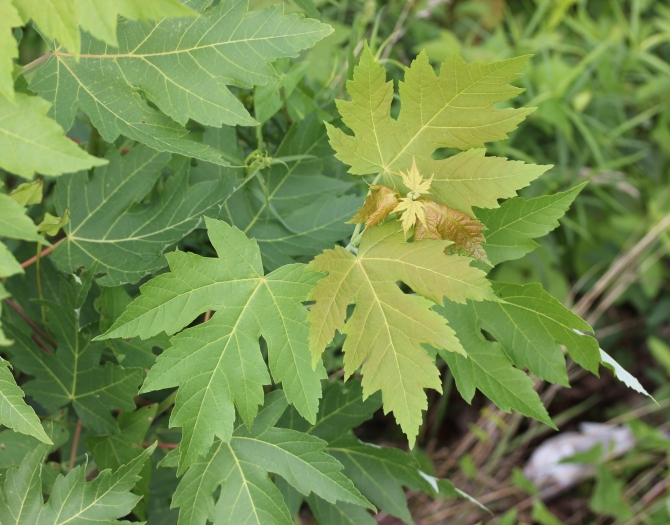Silver Maple
(Acer saccharinum)
Silver Maple (Acer saccharinum)
/
/

Even Dankowicz
CC BY 4.0
Image By:
Even Dankowicz
Recorded By:
Copyright:
CC BY 4.0
Copyright Notice:
Photo by: Even Dankowicz | License Type: CC BY 4.0 | License URL: http://creativecommons.org/licenses/by/4.0/ | Rights Holder: Even Dankowicz | Publisher: iNaturalist | Date Created: 2018-07-29T14:01:25-07:00 |












































































Estimated Native Range
Summary
Acer saccharinum, commonly known as Silver Maple, is a deciduous tree native to riparian zones, floodplains, and wetlands of the Southeastern, Midwestern, Northeastern U.S., and Ontario. It is a fast-growing species, usually reaching 49–82 feet (15–25 meters) in height with a spread of 36–49 feet (11–15 meters). The Silver Maple has a broad, rounded crown with deeply lobed leaves that are silvery-white beneath, giving the tree its common name. It produces small, inconspicuous red or yellow flowers in early spring before the leaves emerge, followed by winged samaras (helicopter seeds). The autumn foliage is generally pale yellow, though some trees may display more vibrant yellow, orange, or red hues.
The Silver Maple is valued for its rapid growth and adaptability to a range of soil conditions, including wet soils. It is often used for urban plantings, street trees, and as a shade tree in residential landscapes. Despite its adaptability, the tree’s brittle wood makes it susceptible to storm damage, and its aggressive root system can cause problems with infrastructure. It thrives in full sun to part shade and prefers moist, well-drained soils but can tolerate a variety of soil types, including compacted urban soils. Gardeners should be cautious when planting near buildings or pavement due to its invasive roots.CC BY-SA 4.0
The Silver Maple is valued for its rapid growth and adaptability to a range of soil conditions, including wet soils. It is often used for urban plantings, street trees, and as a shade tree in residential landscapes. Despite its adaptability, the tree’s brittle wood makes it susceptible to storm damage, and its aggressive root system can cause problems with infrastructure. It thrives in full sun to part shade and prefers moist, well-drained soils but can tolerate a variety of soil types, including compacted urban soils. Gardeners should be cautious when planting near buildings or pavement due to its invasive roots.CC BY-SA 4.0
Plant Description
- Plant Type: Tree
- Height: 50-90 feet
- Width: 35-50 feet
- Growth Rate: Rapid
- Flower Color: N/A
- Flowering Season: Spring
- Leaf Retention: Deciduous
Growth Requirements
- Sun: Full Sun, Part Shade
- Water: Medium, High
- Drainage: Fast, Medium, Slow
Common Uses
Bank Stabilization, Bee Garden, Bird Garden, Butterfly Garden, Deer Resistant, Erosion Control, Low Maintenance, Salt Tolerant
Natural Habitat
Riparian zones, floodplains, and wetlands
Other Names
Common Names: River Maple, Creek Maple, Soft Maple, White Maple, Large Maple, Swamp Maple, Silverleaf Maple, Silber-Ahorn, Plaine Blanche, Plaine De France
Scientific Names: , Acer saccharinum, Acer dasycarpum, Acer saccharinum f. laciniatum, Acer saccharinum var. laciniatum, Acer eriocarpum, Acer saccharinum var. wierii, Acer dasycarpum var. laciniatum, Acer wieri, Acer collinsonia
GBIF Accepted Name: Acer saccharinum L.